The Tale of Daniel
It’s April Cools! It’s like April Fools, except instead of cringe comedy you make genuine content that’s different what you usually do. For example, last year I talked about the strangest markets on the internet. This year I went down a different rabbit hole.
Daniel has been a top 5 baby name twice since 2000. There are over 1.5 million Daniels in the United States (and almost 100,000 last-name Danielses). There are who knows how many Dans, Dannies, and Daniellas out there. “Daniel” is, by any way you slice it, a very modern name.
It may be the oldest attested name in common use.
Last year was Chicago’s last Newberry Library book sale. Part of my haul was several collections of ancient literature:

I’m interested in ancient history, which shouldn’t be a surprise to anybody who reads this blog. And I love how their literature reflects the modern human experience. Take this lament carved in a pyramid from the Egyptian Middle Kingdom:
I have heard the words of Imohotep and Hardedef \ Whose sayings are recited whole. \ What of their places?
Their walls have crumbled, \ Their places are gone, \ As though they had never been! (pg 196)
This anonymous poet, writing 4500 years ago, shares our fears about losing our past and of our memories being forgotten. Beautiful.
But I found something far more relevant in the Mesopotamian literature.
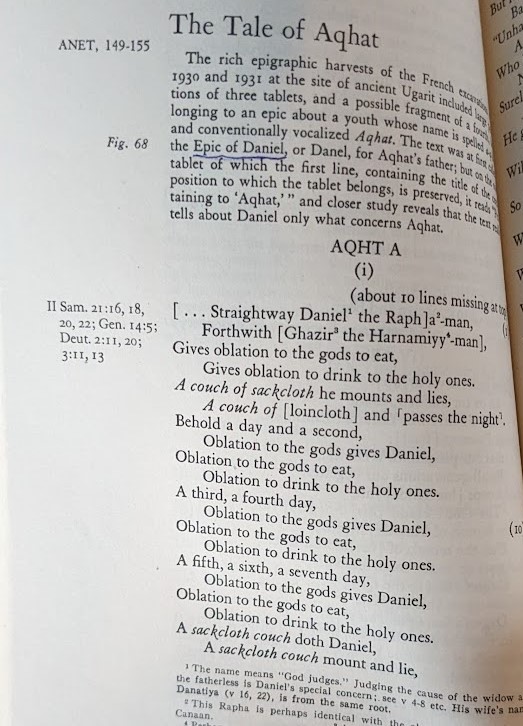
Straightway Daniel the Raphaman … gives oblations to the gods to eat (pg 118)
Daniel the Raphaman
DANIEL
The story comes from the Tale of Aqhat, pulled out of the ruins of a forgotten city, estimated to approximately 1350 BCE. That’s a hundred years older than the oldest known Chinese writing, one thousand years older than the book of Daniel, and thirty-four hundred years before today. I needed to know if this was the same name, transmitted across cultures, stretching 3400 years of unbroken “Daniels” to our modern day. Is this where “Daniel” comes from, or is just a strange coincidence?
A historian of the modern world has to learn how to sip from a firehose of evidence, while the historian of the ancient world must learn how to find water in the desert. — Bret Devereaux
I’ve done some historical work before, but all of it was in software, a “history of the modern world”. I decided to try anyway. This is what I’ve put together from reading books and trawling JSTOR.1
This is the tale of Daniel.
Ugarit
Obviously, finding an unbroken lineage of specific Daniels across three millennia is impossible. Instead, I want to learn if the name was in the “cultural consciousness”. If so, we can be modestly confident that real people are getting named Daniel, like how real people are being named Khaleesi today.
So let’s start with where the name was first found. Ugarit was a port city of the shores of Ras Shamra, unknown until 1928. Scholars believe that it was a city of roughly 8,000 people and the capitol of a kingdom of 20,000 (ref). While never a great power, Ugarit was a fairly “literate” society and had extensive trade relations with all of the regional powers.
Along with a trove of archaeological material (pots and doodads), excavators also found large collections of clay tablets. Like with many Bronze Age civilizations, most of these recovered documents are either religious, diplomatic, or administrative. That’s because clay tablets are expensive and only reserved for important matters. Most of these were dated to very approximately 1500-1200 BCE.
But also in that collection, we found three piece of literature. The first, the Baal Cycle, tells of how Baal Hadad became one of the great gods of the Ugaritic pantheon. The second, the Legend of Keret, probably matters a lot to another person chasing a completely different white whale, but doesn’t matter to me. The final one, the one that started this obsession of mine, is the Tale of Aqhat.
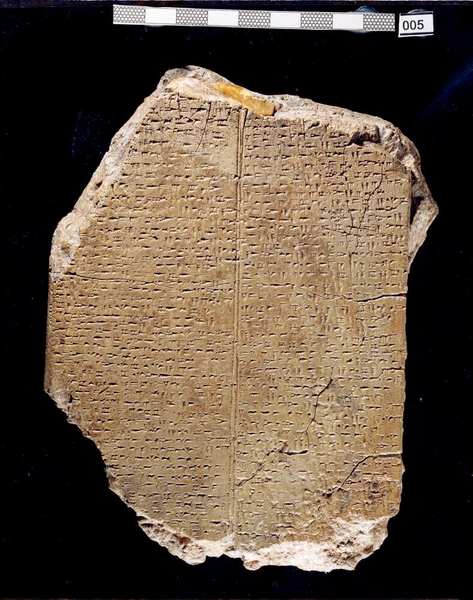
I found this picture in the InscriptiFact collection. Sadly no digital transcription! It tells of the story of the great hero Aqhat, who was loved and murdered by the goddess Anath. But I don’t actually care about any of that, I’m only after the Daniel. I’m pretty sure this is Daniel’s name:
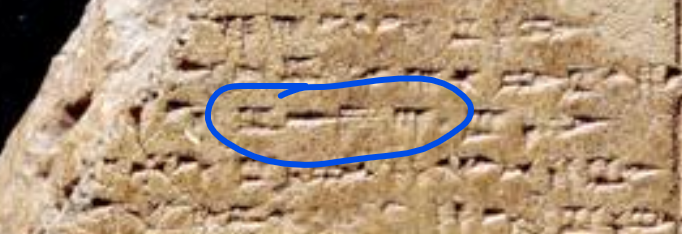
I have a few friends who can read cuneiform, so I asked if any understood this text. I found out 1) that’s like asking a person who “can read ASCII” if they can understand Spanish, and 2) this is not actually cuneiform. It’s just an alphabet that looks like cuneiform.
Aqhat’s father is 𐎄𐎐𐎛𐎍. Left to right: D, N, ‘I, L. “Judged by El”, El being the chief God in the Ugaritic pantheon.
The name could be older than this text, since most early written myths were first oral traditions. This is just the first time the name “Daniel” is attested. The name could also be a lot younger, at least the modern name. The old name could just be an unusual coincidence, like how people in both England and China have the last name “Lee”.2 For “Daniel” to be that old, it’s not enough for the Ugarits to have had the name, it has to come from them, in a chain of Daniels reaching into present.
And here we run into a problem. We know roughly how old the tablets are because we know roughly when the city collapsed. By cross-referencing names of Egyptian rulers that appear in Ugarit tablets with the much better preserved Egyptian corpus, historians estimate that the city collapsed around 1190 BCE. This corresponds with the “Bronze Age Collapse”, a cataclysmic era where dozens of cities and kingdoms in the region are turned to ruins. Scholars still don’t have a clear picture why.
Regardless of the why, the Ugarites disappeared from history. The name Daniel would have to be carried by a new generation.
But this is also where the chain breaks.
Phoenicia
The Ras Shamra find was a one-in-a-million miracle, an enormous corpus of about 40,000 words, roughly as much as one Harlequin romance novel. After that? Well, here’s the Hadad Statue:
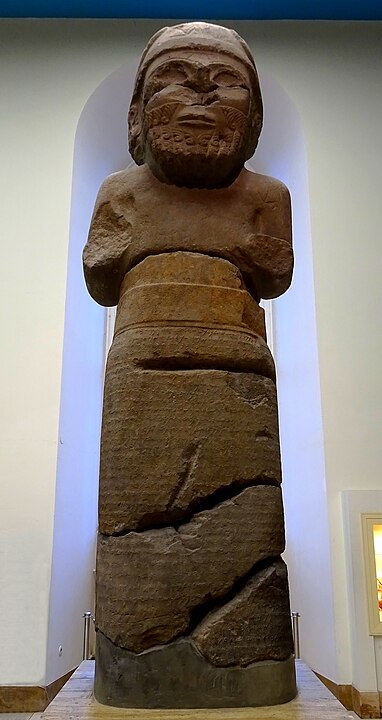
If you look closely, you can see the bottom is covered in faint writing. The language is “Samalian”, one of the many languages in the region. The engraving is roughly 400 words long and represents over half of all Samalian. This essay is four times longer than the Samalian corpus.
So what happened? It’s easy to imagine the Bronze Age Collapse turning the broader region into a Stone Age wasteland, but the archaeological evidence suggests the opposite. Rather, it points to a rapid economic recovery of the region, with new kingdoms soon establishing a large number of seafaring trade routes. Eventually they’d come in contact with the Greeks, who’d call all of the many distinct groups “Phoenicians”.
But we know so little of what the “Phoenicians” (in all their languages) wrote because of how they wrote it. Instead of Ugarit’s clay tablets, the Phoenicians used papyrus. Papyrus is lighter and cheaper, but also rots after a few decades. The fragments of text we do have— with one big exception— are engravings.3 Inscriptions on tombs, statues, weapons, etc. This is a major problem for historians, but an even bigger problem for me, because it makes the question of Daniel impossible to answer.
Nonetheless, we can look for clues that the same stories persisted, even if we don’t have concrete evidence. Let’s start with the first two lines of the Hadad statue:
𐤀𐤍𐤊 𐤐𐤍𐤌𐤅 · 𐤁𐤓 · 𐤒𐤓𐤋 · 𐤌𐤋𐤊 · 𐤉𐤀𐤃𐤉 · 𐤆𐤉 · 𐤄𐤒𐤌𐤕 · 𐤍𐤑𐤁 · 𐤆𐤍 · 𐤋𐤄𐤃𐤃 · 𐤁𐤏𐤋𐤌𐤉· 𐤒𐤌𐤅 · 𐤏𐤌𐤉̇ ·· 𐤀̇𐤋𐤄𐤅 ·· 𐤄𐤃𐤃 · 𐤅𐤀𐤋 · 𐤅𐤓𐤔𐤐 · 𐤅𐤓𐤊𐤁𐤀𐤋 · 𐤅𐤔𐤌𐤔 · 𐤅𐤍𐤕𐤍 · 𐤁𐤉𐤃𐤉
This is the “Phoenician alphabet”—the same one that inspired the Greek alphabet— which many distinct cultures in the region used for their own languages. Unlike Ugaritic, it’s read right-to-left. Scholars don’t think this alphabet descended from Ugaritic, but the two writing systems are closely related: the same sounds appear in roughly the same places in the alphabet.4 Here’s the translation (from wiki):
I am Panamuwa, son of Qarli, king of Y’DY, who have erected this statue for Hadad in my eternal abode (burial chamber). The gods Hadad and El and Rašap and Rākib-El and Šamaš supported me.
The same gods, El and Baal Hadad, are important gods in the Ugarit corpus! And this is coming four hundred years after the fall of Ugarit. It suggests the Baal Hadad and El weren’t local gods to the Ugarits, but regional gods, part of a shared culture. The tale of Aqhat could have been preserved as a literary tradition, just on sources we don’t have anymore. And with Aqhat comes his dad(niel).
To get out of the Daniel dark ages, we have to look at a different inscription found 600 miles away.
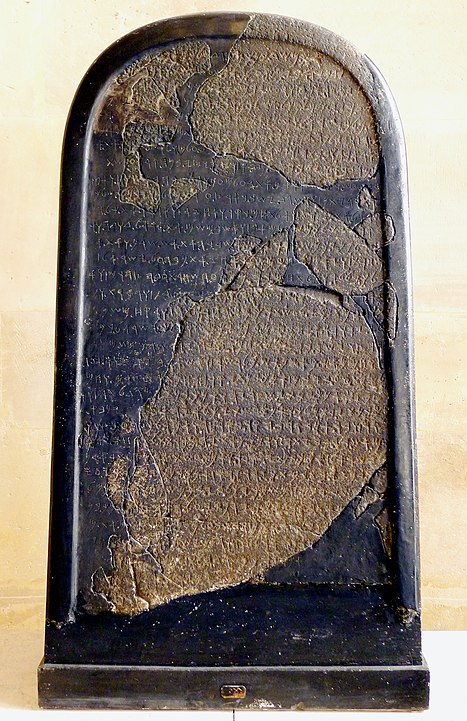
Like the Hadad statue, the Misha Stele is one of our only sources on a long-dead language. In this case, Moabite. It’s a distinct language from Samalian but this uses the same Phoenician alphabet. Here’s a sample (also from wiki):
I have built its gates and I have built its towers. I have built the palace of the king, and I made the prisons for the criminals within the wall. And there were no wells in the interior of the wall in Karchah. And I said to all the people, ‘Make you every man a well in his house.’ And I dug the ditch for Karchah with the chosen men of Israel.
Israel?
Yes, Israel.
The Greeks called this region Phoenicia, but the locals always called it Canaan. The same “Canaan” from the Bible. The Israelites were a Canaanite population with Canaanite religions: Israel literally means One who fought El. Slowly, over years and centuries, they developed their own ethnic identity. At some point, there were two Israelite kingdoms: the kingdom of Israel/Samaria in the north and the kingdom of Judah (where we get “Jew”) in the south.
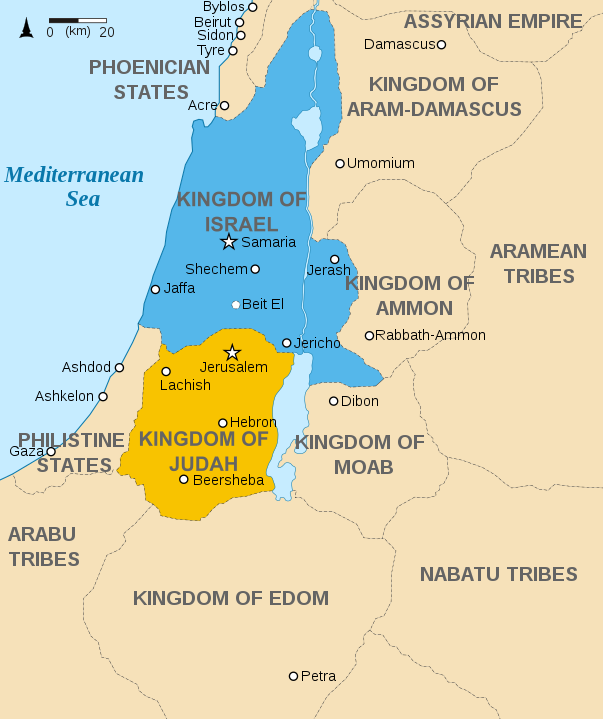
Israel was conquered in 720 BCE while the kingdom of Judah limps along, in one form or another, until 130 CE.5 And it’s through the people of Judah that we have the best corpus of that region’s writing.

The Tanakh6, or “Old Testament”, is a 300,000 word corpus of ancient Hebrew, chronicling the stories, religious practices, and history (mythic and attested) of the Jews.7 It’s the reason we can decipher the scant inscriptions of other Canaanite languages like Moabite, Samalian, and even Ugaritic itself!
And it’s where the tale of Daniel continues.
Judah
Quick recap on Daniel so far: we know the Ugarites wrote about a son of Daniel, the Canaanites (nee Phoenicians) shared a culture with the Ugarites, and the Israelites shared a culture with the Canaanites.
In 600 BCE, the Neo-Babylonian empire conquered Judah, which leads to the sixty year “Babylonian exile” of Jews from Canaan. It’s allegedly during this time that we get the collection of prophecies known as the “Book of Ezekiel”.8 Mostly it’s about how the Jews lost the favor of God and will one day earn it back, and with it redemption.
Far, far more importantly, it marks the triumphant return of Daniel.
“Son of man, if a land sins against Me by trespassing grievously, I shall stretch forth My hand upon it and break its staff of bread, and I shall send famine upon it and cut off from it both man and beast. Now should these three men be in its midst- Noah, Daniel, and Job-they would save themselves with their righteousness, says the Lord God.9 — Ezekiel 14:13-14
Daniel is written (דנאל). As a distant descendent of Phoenician, Hebrew reads right-to-left: Daled, Nun, Aleph, Lamed. “God judged me.” Same meaning as the Ugaritic name, same letters as 𐎄𐎐𐎛𐎍.
I’m amazed that the same meaning can be preserved across so many centuries. But I also want to be as thorough as possible. Two names, eight hundred years apart, with the same meaning, is still not enough for me. I still worry that it could just be an enormous coincidence that two cultures in the same region, speaking sister languages, came up with the same name-meaning.
Ezekiel provides the missing link. In the Tanakh, both Noah and Job are treated as pious men, but critically, neither are Israelites.10 Making Daniel part of the trio implies he was also a righteous non-Jew.
Ezekiel would expect people would know who “Daniel” was if he used that name. This would make sense if Daniel was, say, a righteous figure in the broader Canaanite folklore. At least the Tale of Aqhat implies he was a righteous and just man who was worthy of El’s blessing. He prayed for a son and his wish was granted. He’d be a distinct character, a known righteous non-Israelite, which Ezekiel used as a point of reference.
A tenuous chain, I know, but enough to persuade me at least. Enough to persuade other scholars too. It may be the best we’ll ever do.
We can finally use the Bible to establish that Daniel wasn’t just a folkloric name, but a name people actually used. From the Book of Ezra:
And these are the heads of their father’s houses and the lineage of those who ascended with me in the kingdom of King Artaxerxes from Babylon. Of the sons of Phinehas, Gershom: of the sons of Ithamar, Daniel; of the sons of David, Hattush. — Ezra 8:1-2
And these were the sons of David who were born to him in Hebron: the firstborn, Amnon, to Ahinoam the Jezreelitess; the second, Daniel, to Abigail the Carmelitess. — Chronicles 3:1
If they’re using Daniel as the name of a minor son of a minor figure, it’s probably a real name.
The False Daniel
But now we have a problem.
The Ezekiel Daniel has four letters. But all of the later Daniels have five: Daled, Nun, Yud, Aleph, Lamed (דניאל) .
It’s still possible to read the four-letter version as “Daniel” but it’s more likely to be “Danel” or “Danil”. And, Ezekiel’s Daniel being closest to the Ugaritic DN’IL, suggests that DN’IL was also “Danel”. That’s how most modern scholars now transliterate the name.
So yes, I may have been chasing a false Daniel this whole time. Theophanu is not Tiffany, after all. Maybe “Daniel” is at best attested from 600 BCE, putting it in contention with things like Debrah and Zhou. There is a tradition to pronounce the Ezekiel DN’IL as “Daniel”, so it could be the actual pronunciation and the Yud was added later. I don’t know when the tradition started, though. At the very least, this strengthens the connection between Ezekiel’s דנאל and the Ugarite’s 𐎄𐎐𐎛𐎍: Ezekiel was working off a different name than the rest of the Tanakh authors.
Then again, maybe this is all just quibbling over specifics. The Latin alphabet wasn’t meant for Canaanite names, and the Hebrew alphabet wasn’t meant for Ugaritic ones. The Biblical שרה could be Romanized as “Sarah” or “Sara”, חנכה could be Hannukah, Channuka, or Chanukah. Maybe it doesn’t matter whether 𐎄𐎐𐎛𐎍 is דניאל or Danel or דנאל or Daniel. It’s still the same name.
Regardless, we’re following a chain, and there’s still one more link.
From Daniel to Today
There’s one last question here: lots of people use Tanakh names, like Sarah and Benjamin and David. But many Tanakh names, like Tamar and Yehuda and Hillel, are only used by Jews. Why is Daniel in the former group and not the latter?
I’d speculate that the difference is how likely it is for a Christian reader to encounter the name. “Adam” appears in the first book of Genesis, while Shamgar is a minor figure in the book of Judges. Christians would most likely encounter names that appear either really early, have entertaining stories, or are directly relevant to the New Testament.
And here’s where we finally get to the last link between then and now: the Book of Daniel. Like the Book of Ezekiel, this recounts the story of someone living during the Babylonian exile. Unlike Ezekiel, it was pretty clearly written four hundred years after the exile. Daniel contains an awful lot of prophecies that seem very relevant to the Greek occupation (the one that leads to the story of Channukah). The most famous of them is the prophecy of 70 weeks:
And you shall know and understand that from the emergence of the word to restore and to rebuild Jerusalem until the anointed king [shall be] seven weeks, and [for] sixty-two weeks it will return and be built street and moat, but in troubled times. — Daniel 9:25
Later writers took this to be a prophecy about Jesus. I don’t admit to understand how it’s supposed to be about Jesus, but it is. So the book of Daniel is really important in Christian thought. This kept the name “Daniel” in the Christian mainstream for the next 2000 years, carrying it across the world to Europe and India and East Asia and South America, all the way to the present daytoday. The end of a 3400 year chain.
So that’s the story of the name of Daniel, from an ancient clay tablet to the millions of Daniels alive now.
I want to reiterate that I’m not a trained historian and almost certainly got a lot of details wrong. Also, this isn’t and wouldn’t pass peer review. Don’t cite this for a class paper. Happy April Cools!
Thanks to Predrag Gruevski for feedback. If you enjoyed this, check out the April Cools website for all the other pieces this year!
- I accessed JSTOR as a UChicago Alumnus benefit, but I also found out that anyone with a Chicago public library card has access too! Hundreds of public libraries do this! [return]
- Note though that the Chinese “Lee” is just one possible Romanization of 李. “Li” is another. [return]
- We have a much larger Egyptian corpus because papyrus lasts longer in Egypt’s hot and arid climate. We have large Greek and Roman corpuses because monks tirelessly copied old texts into new books for centuries. Volcanoes helped. [return]
- We know the order because we’ve recovered Ugarit abedecaries (inscriptions of all an alphabet’s letters in order). [return]
- At least, that’s when Jews were permanently expelled from the region. Growing up I was taught that the important event was the burning of the Second Temple, which happened in 70 CE. [return]
- I originally wrote “the Torah” here, but as one commenter pointed out, the Torah is just the first five books of Moses. The Tanakh also includes the Nevi’im and Ketuvim, both of which I rely on later in the essay. I know all my old Rebbes are very disappointed in me. [return]
- I grew up an Orthodox Jew, and it’s extremely weird to study the actual history of your religion. Like vivisecting holy books. [return]
- From my research it seems that it’s generally accepted that most of Ezekiel is written contemporaneously with the Babylonian exile, though it may have been smoothed out later. [return]
- For Old Testament verses I’m using the Chabad translations. My Hebrew never got past a first grade level. [return]
- Noah is obvious: his story takes place before Abraham’s. Job is tougher, as there’s nothing in the story that makes it clear he’s not Jewish. I’m basing this off the claims of many different Rabbis and modern scholars. [return]